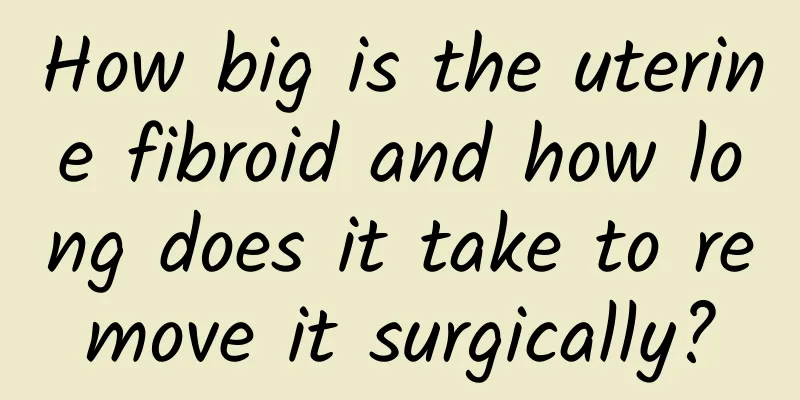How big is the uterine fibroid and how long does it take to remove it surgically?

|
Generally, surgery is recommended when the diameter of uterine fibroids exceeds 5 cm, but not all cases require immediate removal. The necessity of surgery depends not only on the size of the fibroids, but also on the patient's specific symptoms and health status. The time of surgery is not fixed either. The time will vary depending on the surgical method, such as open surgery or laparoscopic surgery. 1. Fibroid size and necessity of surgery The size of the uterine fibroid is an important factor in deciding whether to have surgery, but it is not the only one. Surgery is usually recommended for fibroids larger than 5 cm, especially when the fibroids cause obvious symptoms, such as heavy menstrual bleeding, severe abdominal pain, or pressure on surrounding organs. However, whether surgery is necessary also needs to be considered, such as the patient's fertility plan, age, and the growth rate of the fibroids. 2. Symptoms and surgical indications Surgery may be necessary when uterine fibroids cause heavy menstrual bleeding and anemia, and medical treatment is ineffective. Other situations where surgery may be considered include: severe abdominal pain, dyspareunia, chronic abdominal pain, acute abdominal pain caused by torsion of the fibroid, or discomfort caused by fibroids pressing on organs such as the bladder and rectum. Surgery should also be considered if fibroids are confirmed to be the only cause of infertility or recurrent miscarriage, or if there is a suspicion that the fibroids may become malignant. 3. Surgical method and time The choice of surgical method will affect the operation time. Open surgery usually takes less time because the surgical field is wider and a variety of instruments can be used. Laparoscopic surgery requires more delicate operations and usually takes longer. The intraoperative situation will also affect the operation time, such as whether there are adhesions in the abdominal cavity. 4. Choice of surgical type For patients who wish to retain their fertility, myomectomy can be an option. Submucosal myomas or most intramural myomas that protrude into the uterine cavity can be removed through hysteroscopy, and submucosal myomas that protrude into the vagina can be removed vaginally. There is a 50% chance of recurrence after surgery, and about 1/3 of patients may need another surgery. 5. Applicable cases of hysterectomy When patients do not need to preserve their fertility or suspect that fibroids have become malignant, hysterectomy is an option, including total hysterectomy and subtotal hysterectomy. Before surgery, doctors usually perform cervical cytology to rule out the possibility of cervical intraepithelial neoplasia or cervical cancer. Especially in perimenopausal patients, be alert to the risk of combined endometrial cancer. The treatment of uterine fibroids requires comprehensive consideration of multiple factors, and surgery is only one of the options. Patients should fully communicate with their doctors and choose the most appropriate treatment plan based on their own situation. I hope this article can provide you with some help and inspiration. |
<<: How long should I stay in bed after laparotomy for uterine fibroids?
>>: What are the dangers of thick endometrium?
Recommend
Avocado helps with weight loss, bowel movements, and is good for the cardiovascular system! Ketogenic diet is essential, 3 tips to eat smartly
Avocado, known as the "cream of the forest&q...
What are the reactions to the last three pills of medical abortion?
The last three pills of medical abortion are to s...
What grade of disease does uterine fibroids belong to? What grade of disease does uterine fibroids belong to?
What grade of disease does uterine fibroids belon...
Is menopausal irregular menstruation common? 7 causes of menopausal irregular menstruation
1. First of all, it is necessary to confirm wheth...
Can I still get pregnant after ectopic pregnancy surgery?
Ectopic pregnancy brings great harm to women, not...
What are the symptoms of pelvic inflammatory disease?
Gynecologists say that pelvic inflammatory diseas...
What are the symptoms of white lesions of the vulva?
What are white lesions of the vulva? What are the...
Will cervical warts become serious and affect life?
Cervical warts are a curable disease. To treat ce...
How long does it take for a child's abdominal lymphadenitis to get better?
It usually takes 1 to 4 weeks for children to rec...
What is the reason for heavy menstrual flow? Beware of the dangers of heavy menstrual flow
Heavy menstrual flow in women may be a gynecologi...
Early clinical symptoms of cervicitis
Cervicitis has seriously affected our lives in re...
Can third-degree cervical erosion heal itself? The most serious degree
Gynecological diseases have always been a common ...
Experts briefly analyze the common symptoms of chronic cervicitis
The symptoms of chronic cervicitis are a matter o...
How do you get cervicitis? How can you prevent it?
Cervicitis is a gynecological disease, which is m...
Five major factors causing dysmenorrhea in women
Those few days of the month are already very trou...









